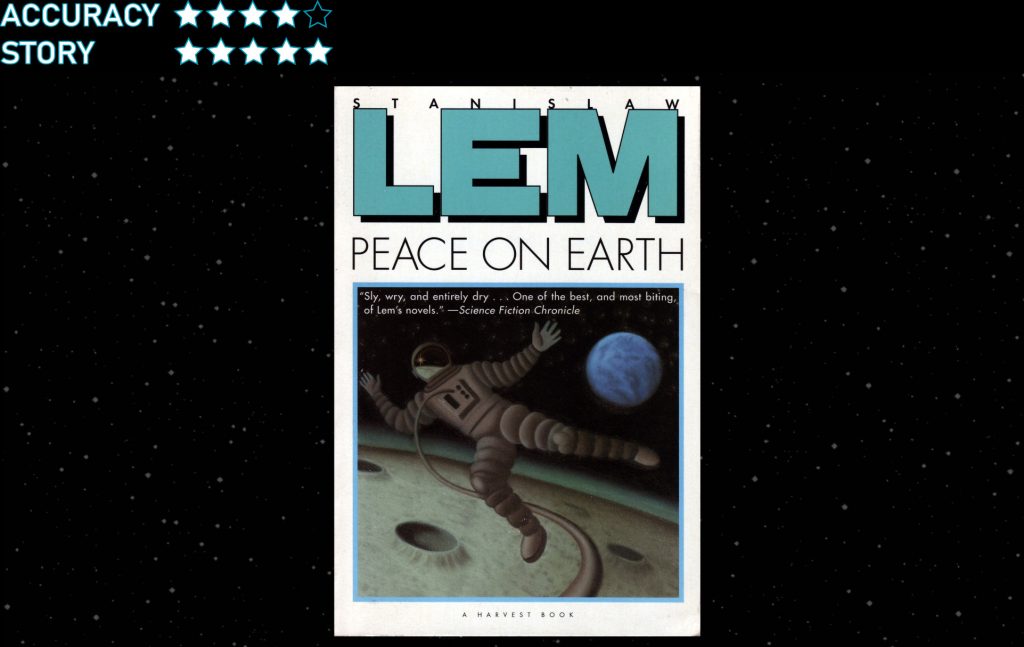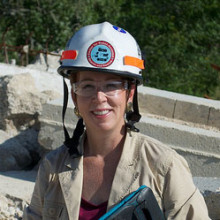
Robohub.org
Peace on Earth (1987): Using telerobotics to check in on a swarm robot uprising on the Moon

Robots: humanoids, teleoperated reconfigurable robots, swarms.
Recommendation: Read this classic hard sci-fi novel and expand your horizons about robots, teleoperation, and swarms.
Stanislaw Lem was one of the most read science fiction authors in the world in his day, especially the 70s and 80s, though not in America because there were rarely translations from his native Polish to English. Europeans could parse the French translations, we couldn’t even parlez vous francais. Lem famously did not like American science fiction, with a very few exceptions. One being Philip K. Dick- and it is no wonder since Lem’s 1987 novel Peace on Earth shares many of the same themes that Dick covered: militarization of robots, people losing their memory or not being what they seem, and government conspiracies. In some ways Peace on Earth is like the longer, more detailed, and, actually, *better* version of Dick’s 1953 short story Second Variety (which was basis for the Peter Weller movie Screamers).
Peace on Earth has a sort of a Battlestar Galatica (reboot) backstory. Mankind has put all their military robots on the moon to do whatever military robots do. The rapidly evolving, super smart robots can continue to use simulations and machine learning to improve or work out alternatives to Clauswitz style of warfare but out of the way so that it can’t impact humans.
Or can it?
Except after a couple of decades no one has heard from the robots. This is not unexpected, but people, being people, are beginning to wonder if the robots are still up there. Or maybe the robots have evolved into something peaceful. Or into some supreme intelligence that might want to take over the Earth. Or maybe the robots have run out of things to shot at up there and the winners are now thinking about shooting at Earth. Oooops. Maybe we should send someone to check in on them, just in case…
The story is told from the viewpoint of the astronaut, Ijon Tichy, sent to check in on the robots. The book starts with his return on Earth with brain damage that has severed his corpus callosum, left him with major memory loss as to what happened and why he is on the run. We are in Christopher Nolan Momento territory (without the tattoos) or Jonathan Nolan’s/HBO’s Westworld out of sequence story telling as Tichy tries to figure out what happened on the Moon and what it means.
Along the way we get some interesting descriptions of telerobotics and telepresence as well as swarm and distributed robotics. Lem was a hard science ficition writer, who had gone to medical school before switching to physics. He was very much into the science component of his books and in this case more of the ideas of biological evolution. He posits that biological evolution has been about the evolution of small to large— from viruses and bacteria to single cells to animals and people, but that robotics evolution will be from large to small. We started with big robots improving, then getting smaller with miniaturization of sensors and actuators, then smaller computation as a single robot would not need to carry all its computation onboard but could rely on distributed computation, and the trend will continue finally a robot becomes a collection of tiny, simple robots that can cast itself into a larger shape with greater intelligence— the idea behind Michael Crichton’s novel Prey. These swarms of what we would now call nanorobots would provide the ultimate flexibility in reconfigurable robots. Of course, Lem hand waves over limiting factors such as power and communication. But that aside, it’s a thought-provoking idea and a radically different take than Dick’s on how military robots would evolve.
One of the interesting scientific themes in Peace on Earth is Tichy’s use of teleoperation robots to land on the Moon and attempt to check out the robots in the different sectors of the Moon. Eventually Tichy quits using humanoid robots and begins using a reconfigurable robot body that can transform into different animal shapes so as to move more effectively through the different structures built by the robots.
Teleoperated robots are sometimes called avatars, though the term avatar was originally restricted to software simulations- James Cameron changed that connotation with his movie. There is increasing interest in telecommuting (and telesex) through robots, so much so, there is now a XPrize competition on avatars.
My favorite shape that Tichy’s teleoperated robot took on was that of a dachshund. And here is where Lem underestimated the scientific challenges of teleoperation. Lem focused on the physical science— how the avatar might reconfigure into a new shape. He assumed that Tichy would have little difficulty adjusting to the new shape because Tichy would be wearing a suit that sensed his body movements. Except this ignores the human-robot interaction component— how does Tichy know to move like a dog and synthesize perception from angles much lower than a human? The degrees of freedom are different, the movement patterns are different, the location of sensors are different. Operators get rapidly fatigued with humanoid robots where there is a one-to-one correspondence between the human and robot and there is no change in size. The cognitive load for trying to control a four legged animal would be huge. It is hard to imagine that Tichy would be successful without an intermediary intelligent assistance program that would translate his intent into the appropriate motions for the current shape.
And that type of assistive AI is a hard, open research question.
The XPrize ANA Avatar competition is making a similar assumption, that if you can build a humanoid avatar, it will be easy and natural for a human to control. That hasn’t been supported by decades of research in telerobotics and the humanoid robots in the DARPA robotics challenge often required multiple operators.
But back to Peace on Earth. It’s a very readable book jam packed with scientific ideas that were ahead of its time, combined with a serious jab at the stupidity of the nuclear arms race that was in progress at the time.
More importantly, Lew foresaw a world in which robots could be a threat, though politicians were a bigger threat, and were a solution to the threat. A refreshing take on robotics and the New World Order. What a shame Lem has been relatively unknown in the US.
You really should read this one, especially if you like hard science fiction like Arthur C. Clarke or if you want to get beyond the US viewpoint of sci-fi.
For an audio version of this review, click below…
Original article posted in Robotics Through Science Fiction blog.




